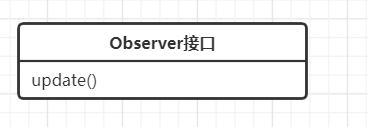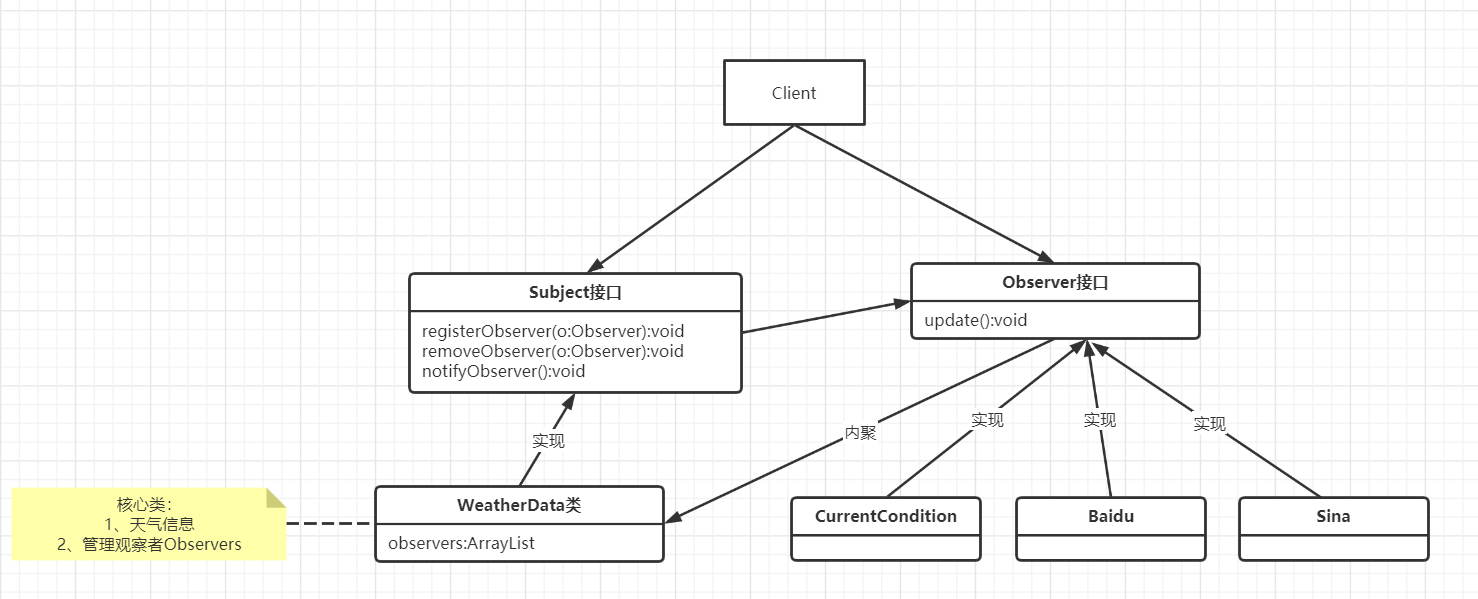一、观察者模式
1、 案例
1.1 天气预报项目需求
- 气象站可以将每天测量到的温度,湿度,气压等等以公告的形式发布出去(比如发布到自己的网站或第三方)。
- 需要设计开放型API,便于其他第三方也能接入气象站获取数据
- 提供温度、气压和湿度的接口
- 测量数据更新时,要能实时的通知给第三方
1.2 普通方案1
通过对气象站项目的分析,我们可以初步设计出一个WeatherData类

说明:
- 通过getXxx方法,可以让第三方接入,并得到相关信息
- 当数据有更新时,气象站通过调用dataChange()去更新数据,当第三方再次获取时,就能得到最新数据,当然也可以推送
推送示意图如下:
在WeatherData中,每隔一段时间,将dataChange()推送至CurrentConditions中的update方法
CurrentConditions(当前的天气情况)可以理解成是我们气象局的网站//推送

1.3 普通方案代码实例
1.3.1 CurrentConditions类
1 | //显示当前天气情况(可以理解成气象站自己的网站) |
1.3.2 WeatherData类
1 | //类是核心 |
1.3.3 Client类
1 | public class Client { |
结果:
2
3
4
5
6
7
***Today mPressure: 150.0***
***Today mHumidity: 40.0***
==============天气情况变化================
***Today mTempature: 40.0***
***Today mPressure: 160.0***
***Today mHumidity: 20.0***
1.4 普通方案问题分析
- 其他第三方接入气象站获取数据的问题
- 无法在运行时动态的添加第三方
//在WeatherData中,当增加一个第三方,都需要创建一个对应的第三方的公告板对象,并加入到dataChange,不利于维护,也不是动态加入
3.违反了开闭原则,添加新的第三方时,会在下面的代码中进行修改
2
3
4
5
6
7
this.currentConditions = currentConditions;
}
public void dataChange(){
currentConditions.update(getTemperature(),getPressure(),getHumidity());
}
2、观察者模式原理
2.1 Subject
观察者模式类似于订牛奶业务
- 奶站(气象局):Subject
- 用户/第三方网站:Observer

说明:
- Subject:登记注册、移除和通知
- registerObserver注册
- removeObserver移除
- notifyObservers()通知所有的注册的用户,根据不同得到需求,可以是更新数据,让用户来取,也可以是实施推送,看具体需求定
2.2 Observer

说明:
- 观察者模式:对象之间多对一依赖的一种设计方案,被依赖的对象为Subject,依赖的对象是Observer,Subject通知Observer变化,比如这里的奶站是Subject,是1的一方。用户是Observer,是多的一方。
2.3 原理类图

3、代码实例
3.1 Observer接口
1 | //观察者接口,由观察者来实现 |
3.2 Subject接口
1 | public interface Subject { |
3.3 CurrentConditions类
实现Observer接口
1 | public class CurrentConditions implements Observer{ |
3.4 WeatherData类
实现Subject接口
1 | import java.util.ArrayList; |
3.5 Client类
1 | public class Client { |
结果:
2
3
4
***Today mTempature: 10.0***
***Today mPressure: 100.0***
***Today mHumidity: 30.3***
3.6 添加新的观察者
3.6.1 BaiduSite类
实现Observer接口
1 | public class BaiduSite implements Observer{ |
3.6.2 Client类
1 | public class Client { |
结果:
2
3
4
5
6
7
8
***Today mTempature: 10.0***
***Today mPressure: 100.0***
***Today mHumidity: 30.3***
百度网站
***百度网站 气温: 10.0***
***百度网站 气压: 100.0***
***百度网站 湿度: 30.3***
4、观察者模式好处
- 观察者模式设计后,会以集合的方式来管理用户(Observer),包括注册、移除和通知
- 这样,我们增加观察者(这里可以理解成一个新的公告板),就不需要去修改核心类WeatherData,不会修改代码,遵守了ocp原则
5、观察者模式在Jdk应用的源码分析
5.1 源码分析
(1)new 一个Obserable对象
1 | public static void main(String[] args) { |
(2)Obserable类
里面含有Observer,还有3个方法addObserver、deleteObserver、notifyObservers
1 | public class Observable { |
(3)Observer接口
1 | public interface Observer { |
(4)Obserable类中的notifyObservers方法详解
1 | public void notifyObservers(Object arg) { |
5.2 说明
- Observable的作用和地位等价于我们前面讲过的Subject
- Observable是类,不是接口,类中已经实现了核心的方法,即管理Observer的方法,add…,delete…,notiry…
- Observer的作用和地位等价于我们前面讲过的Observer,有update
- Observable和Observer的使用方法和前面讲过的一样,只是Observable是类,通过继承来实现观察者模式